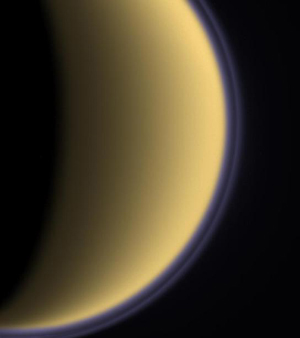
Shrouded in a purple atmospheric haze, a foggy layer of methane and ethane hides geologic features on Titan. A NASA/JPL-Caltec image
WASHINGTON (PTI): Astronomers have discovered a bright, mysterious geologic object - where one never existed - on Cassini mission's radar images of Ligeia Mare, the second-largest sea on Saturn's moon Titan.
Researchers said that scientifically speaking, this spot is considered a "transient feature," and have dubbed it "Magic Island."
This may be the first observation of dynamic, geological processes in Titan's northern hemisphere.
"This discovery tells us that the liquids in Titan's northern hemisphere are not simply stagnant and unchanging, but rather that changes do occur," said Jason Hofgartner, a Cornell University graduate student in the field of planetary sciences, and the paper's lead author.
"We don't know precisely what caused this 'magic island' to appear, but we'd like to study it further," he added.
To discover this geologic feature, the astronomers relied on an old technique - flipping. The Cassini spacecraft sent data on July 10, 2013, to the Jet Propulsion Laboratory at the California Institute of Technology for image processing.
Within a few days, Hofgartner and his colleagues flipped between older Titan images and the newly processed pictures for any hint of change.
This is a long-standing method used to discover asteroids, comets and other worlds.
Prior to the July 2013 observation, that region of Ligeia Mare had been completely devoid of features, including waves.
Titan's seasons change on a longer time scale than Earth's. The moon's northern hemisphere is transitioning from spring to summer. The astronomers think the strange feature may be a result from changing seasons.
Hofgartner and the other authors speculate on four reasons for this phenomenon.
Northern hemisphere winds may be kicking up and forming waves on Ligeia Mare. The radar imaging system might see the waves as a kind of "ghost" island, researchers said.
Another explanation is that gases may push out from the sea floor of Ligeia Mare, rising to the surface as bubbles or sunken solids formed by a wintry freeze could become buoyant with the onset of warmer temperatures during the late Titan spring.
Another reason proposed by the authors is that Ligeia Mare has suspended solids, which are neither sunken nor floating, but act like silt in a terrestrial delta.
The study was published in the journal Nature Geoscience.
 Previous Article
Previous Article Next Article
Next Article











The Indian Air Force, in its flight trials evaluation report submitted before the Defence Ministry l..
view articleAn insight into the Medium Multi-Role Combat Aircraft competition...
view articleSky enthusiasts can now spot the International Space Station (ISS) commanded by Indian-American astr..
view article